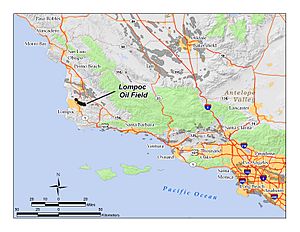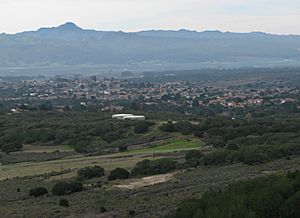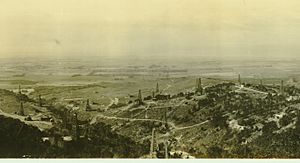Well, Hill 4 facts for kids
Quick facts for kids Well, Hill 4 |
|
|---|---|

Lompoc Oil Field map site of Well, Hill 4
|
|
| Location | Unocal Corporation, Lompoc, Santa Barbara County, California |
| Official name: Well, Hill 4 | |
| Designated | May 1, 1957 |
| Reference no. | 582 |
Well, Hill 4 is a special place in Lompoc, California. It's known as a California Historical Landmark because of its important role in the history of finding oil. This old oil well is located in the Lompoc Oil Field, which is part of the Purisima Hills.
What makes Well, Hill 4 so famous? It was the very first oil well to use a clever new method called pumping cement. This technique helped to seal off water and make sure the oil could be taken out properly. It was a big step forward for the oil industry!
Contents
Discovering Oil at Well, Hill 4
The story of Well, Hill 4 began a long time ago. On September 26, 1905, the Union Oil Company of California started drilling here. They worked hard, digging down 2,507 feet into the ground. That's like drilling through more than 760 meters of earth!
Hitting the Oil Deposit
Finally, on April 30, 1906, they struck oil! This was a huge success. The well kept producing oil for many years, all the way until 1951. That's over 45 years of oil production from this single spot!
How the Well Got Its Name
The well is named after an engineer named Frank E. Hill. He was the leader of the team that first successfully used the pumping cement method to cap the well. His work made a big difference in how oil wells were built and operated from then on.
A Landmark for History
Because of its important invention, Well, Hill 4 was officially recognized as a California State Historical Landmark. This happened on May 1, 1957, and it was given the number 582.
Where to Find the Landmark
Today, Well, Hill 4 is located on land owned by the Unocal Corporation. It's in the Mission Hills District of Lompoc. The special plaque that marks it as a historical landmark, along with the well itself, is about 1.6 miles inside a gated area, hidden away in a canyon.
The Landmark Plaque Says
The official plaque at the site tells us:
- This well was started on September 26, 1905, and finished on April 30, 1906.
- It was the first oil well where a "water shutoff" was achieved by pumping cement through the pipes and behind the casing. This was a new way to stop water from getting into the oil.
- This method was the start of the modern way of cementing wells that is still used today.
- Union Oil Company of California drilled the well to a depth of 2,507 feet.
- The cement work was so good that the well produced oil for more than 45 years!
See also



